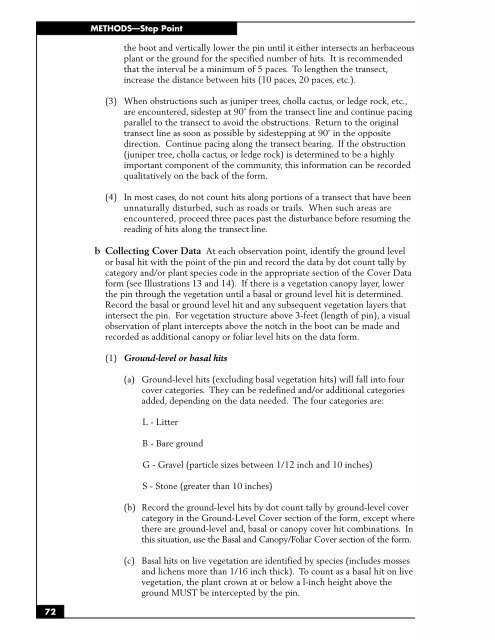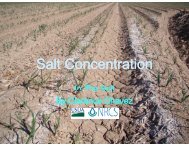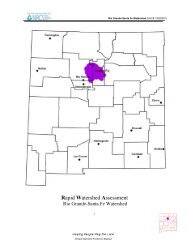SAMPLING VEGETATION ATTRIBUTES - New Mexico NRCS - US ...
SAMPLING VEGETATION ATTRIBUTES - New Mexico NRCS - US ...
SAMPLING VEGETATION ATTRIBUTES - New Mexico NRCS - US ...
You also want an ePaper? Increase the reach of your titles
YUMPU automatically turns print PDFs into web optimized ePapers that Google loves.
72<br />
METHODS—Step Point<br />
the boot and vertically lower the pin until it either intersects an herbaceous<br />
plant or the ground for the specified number of hits. It is recommended<br />
that the interval be a minimum of 5 paces. To lengthen the transect,<br />
increase the distance between hits (10 paces, 20 paces, etc.).<br />
(3) When obstructions such as juniper trees, cholla cactus, or ledge rock, etc.,<br />
are encountered, sidestep at 90˚ from the transect line and continue pacing<br />
parallel to the transect to avoid the obstructions. Return to the original<br />
transect line as soon as possible by sidestepping at 90˚ in the opposite<br />
direction. Continue pacing along the transect bearing. If the obstruction<br />
(juniper tree, cholla cactus, or ledge rock) is determined to be a highly<br />
important component of the community, this information can be recorded<br />
qualitatively on the back of the form.<br />
(4) In most cases, do not count hits along portions of a transect that have been<br />
unnaturally disturbed, such as roads or trails. When such areas are<br />
encountered, proceed three paces past the disturbance before resuming the<br />
reading of hits along the transect line.<br />
b Collecting Cover Data At each observation point, identify the ground level<br />
or basal hit with the point of the pin and record the data by dot count tally by<br />
category and/or plant species code in the appropriate section of the Cover Data<br />
form (see Illustrations 13 and 14). If there is a vegetation canopy layer, lower<br />
the pin through the vegetation until a basal or ground level hit is determined.<br />
Record the basal or ground level hit and any subsequent vegetation layers that<br />
intersect the pin. For vegetation structure above 3-feet (length of pin), a visual<br />
observation of plant intercepts above the notch in the boot can be made and<br />
recorded as additional canopy or foliar level hits on the data form.<br />
(1) Ground-level or basal hits<br />
(a) Ground-level hits (excluding basal vegetation hits) will fall into four<br />
cover categories. They can be redefined and/or additional categories<br />
added, depending on the data needed. The four categories are:<br />
L - Litter<br />
B - Bare ground<br />
G - Gravel (particle sizes between 1/12 inch and 10 inches)<br />
S - Stone (greater than 10 inches)<br />
(b) Record the ground-level hits by dot count tally by ground-level cover<br />
category in the Ground-Level Cover section of the form, except where<br />
there are ground-level and, basal or canopy cover hit combinations. In<br />
this situation, use the Basal and Canopy/Foliar Cover section of the form.<br />
(c) Basal hits on live vegetation are identified by species (includes mosses<br />
and lichens more than 1/16 inch thick). To count as a basal hit on live<br />
vegetation, the plant crown at or below a l-inch height above the<br />
ground M<strong>US</strong>T be intercepted by the pin.




